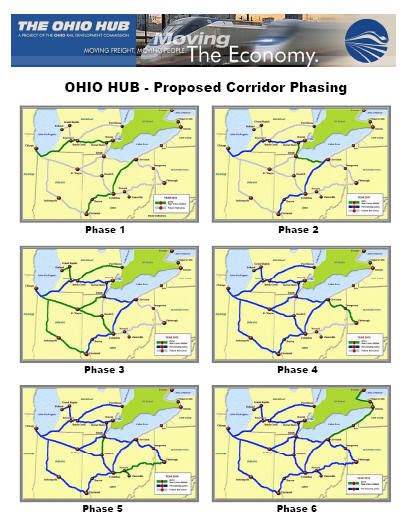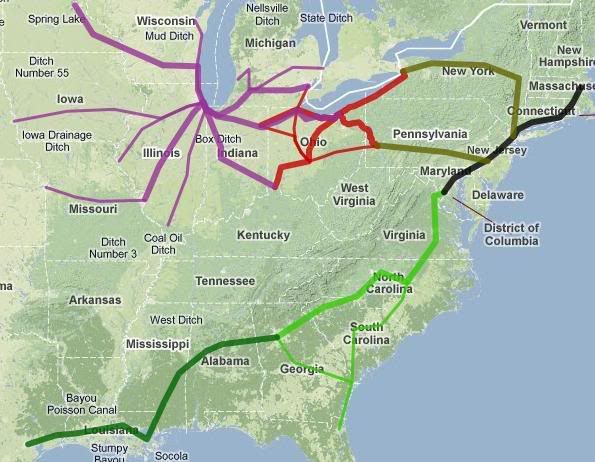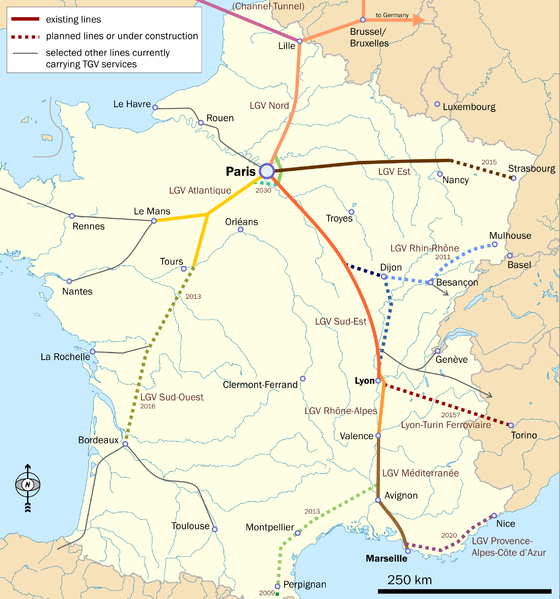(noon. No Olympics until 3 pm. – promoted by ek hornbeck)
Burning the Midnight Oil for Living Energy Independence
 Today’s Sunday Train is focusing on attacks that have been launched against Ohio’s 3C plan, which was granted $400m in the HSR round of Stimulus II grants. There are attacks from Republicans, engaged in their usual games of negotiating in bad faith and basing critiques on focus group testing of talking points rather than substance. There are attacks from “transport experts”, calling for all of our HSR spending to be focused on the coasts with no systems developed to serve the needs of flyover country.
Today’s Sunday Train is focusing on attacks that have been launched against Ohio’s 3C plan, which was granted $400m in the HSR round of Stimulus II grants. There are attacks from Republicans, engaged in their usual games of negotiating in bad faith and basing critiques on focus group testing of talking points rather than substance. There are attacks from “transport experts”, calling for all of our HSR spending to be focused on the coasts with no systems developed to serve the needs of flyover country.
There is even an attack launched against the award of funds to Ohio by President Obama’s Department of Transportation paradoxically by a kossack who goes by the name of “Ohiobama”.
So today is focused on examining the attacks and seeing what there is to them. And lest it seem that this is a single-state issue, many of these same arguments may be used against all of the plans already in place between the Rockies and the Appalachias, as well as the Pacific Northwest and the South Atlantic Coast.
In honor of the “3C” project (Cleveland/Columbus/Cincinnati), I have Three C’s of Attack” the “Conservative” attack, a “Claim-to-Fame” attack, and a “Clown-Train” attack.
The Star of the Show: The 3C Project
 I have written now and again about the Ohio Hub project, sometimes in more length and sometimes less. Above the fold is the original six-stage plan, though if you squint you will see that the first stage could have started running later this year … as with many of these plans, there was been a lot more planning than ground breaking in the previous decades, given the aggressively anti-rail Bush administration (and certainly expected under an administration that would have sold its soul to the oil companies if it had had a soul to sell).
I have written now and again about the Ohio Hub project, sometimes in more length and sometimes less. Above the fold is the original six-stage plan, though if you squint you will see that the first stage could have started running later this year … as with many of these plans, there was been a lot more planning than ground breaking in the previous decades, given the aggressively anti-rail Bush administration (and certainly expected under an administration that would have sold its soul to the oil companies if it had had a soul to sell).
To the right is my sketch that puts the Ohio Hub in the context of the other state-level HSR plans east of the Mississippi, where the Ohio Hub network is in Scarlet (gray being too inclined to get lost in the background).
Not sketched in that map are any plans for an Express HSR system. These are all “Emerging” (110mph) and “Regional” (125mph) systems. Now that work is underway for building the first 110mph segment, as part of the Chicago to St. Louis route, preliminary planning is just getting underway to identify the potential for “Express” (220mph) routes.
And when we consider the model that France used to build and now uses to operate its Express HSR corridors, its not hard to see why the original focus has been on 110mph corridors, many of which could later be upgraded to 125mph corridors.
France started operating its HSR service between Paris and Lyon before the corridor was finished. The original impetus for building the line was the projection that the Paris/Lyon line would reach capacity by 1970. Once it was decided to build a passenger-only corridor to relieve capacity constraints, it was natural to design that new corridor to achieve the most competitive possible passenger service.
 Of course, since France already had an Express Interurban network running substantially faster than Amtrak speeds, once the first segment of the HSR corridor was completed, the France completed the journey to Lyon on the existing express interurban corridor. Then completing an additional segment allowed more of the route to be operated at high speed, and so on until it was finished.
Of course, since France already had an Express Interurban network running substantially faster than Amtrak speeds, once the first segment of the HSR corridor was completed, the France completed the journey to Lyon on the existing express interurban corridor. Then completing an additional segment allowed more of the route to be operated at high speed, and so on until it was finished.
And today, a large number of High Speed Rail routes operate on the French Express HSR network, and then run out onto the Express Interurban network to complete their journey. This means that the capital cost of the HSR corridors are shared by multiple services extending to cities beyond the direct reach of the network.
Which is an excellent model for areas like the Great Lake states, that actually have higher population population density than most of France … except for one thing. We don’t have that Express Interurban network.
And that observation is the foundation of the “run before you fly” approach. Given a large number of corridors that can support quite effective intercity passenger train, and indeed in many cases passenger trains that can generate an operating surplus if only the trains can get there as fast or faster than cars, and given that Emerging HSR corridors are often about 1/5 the cost of Express HSR corridors per mile … first build out an effective Emerging HSR system, and then determine where to, one the one hand, put the Express HSR corridors and, on the other hand, upgrade the Emerging HSR corridors to Regional HSR corridors, to make the most effective total system to serve passengers.
Remember the end of that long-winded sentence: “to serve passengers”. When the technophiles get into the act, that is something that can sometime be lost.
But the 3C starter system is not an Emerging HSR corridor
Now, zoom into Ohio. A Democratic governor, a Democratic State House of Representatives, but only just (and the first time the State House of Representatives have ever changed hands without that party controlling House redistricting), and a Republican State Senate.
And being the Party of No, the Republicans say “No” to the Emerging HSR plan for a wide range of reasons. Its untried, for one, even though the United States once had regional corridor passenger trains running faster than 80mph. The company that did the ridership study did not run rail services, they were just giving a high number to make their client happy. Buckeyes are culturally attached to their cars, and (unlike Pennsylvanians, Michiganivites, or Illini) unwilling to ride trains. $1b+ is too much to risk on such a gamble.
DON’T RUSH AHEAD WITH THIS!!!
Well, OK, one might wish to rush ahead, but if the Senate Majority is not, then its necessary to compromise. The compromise that was arrived at was the starter 3C line. It would be an Amtrak speed service, primarily sharing track with freight services, though with some track upgrades. It would omit a number of the stations proposed for the all-stations service of the Emerging HSR system.
Amtrak did the ridership and feasibility study, and, since a conventional speed rail service requires subsidy, worked out the subsidy that the state would have to pay to get the train up and running.
So, basically 1/3 to 2/5 of the work for an Emerging HSR service would be done, a route would be started, and then we’d see what happened.
Damn! They Gave Us The Money!
It seems that what the Republicans did not expect is that Ohio would in fact get a majority of its application actually funded by the Department of Transport when it came time to hand out the HSR. Because now that it is time to approve receipt of the $400m from the Federal Government, the Republicans are complaining (The Transport Politic).
What are their complaints? Well, a mix of old complaints and new ones. Old complaints: Buckeyes love our cars and we won’t ride these trains. Why Buckeyes will behave completely differently to people who live in Pennsylvania, Indiana, Illinois, Missouri, or North Carolina when they got access to a broader range of transport choices, they do not need to explain, since nobody in the press ever “presses” for actual explanations to back up talking points any more.
I mentioned a “Conservative” columnist last week who just plain lied about the $400m being paid by Ohio, when in fact Ohio’s share of the deficit financed $8b for HSR is about $267m, and we’ve got the same share whether or not our own rail project receives the funds.
However, the newest wrinkle in the Republican attack is to attack the running times. The main reason that the system requires subsidy, after all, is that it is put into operation without all the work required for 110mph trains. So the top speed is 79mph. There is 17% leeway added to a passenger train schedule when it is sharing track with freight, which means that 79mph maximum is 68mph maximum trip speed. Add in slow zones, and the fact that some of the track between Dayton and Cincinnati is not mainline 79mph track in the first place, and the starter system would average about 37mph by a common reckoning.
And then, even though this is the exact service that Amtrak based their ridership study on, they use the slow average speed to question the ridership figures. One trick is to act as if 500,000 projected riders are 500,000 people taking the almost seven hour trip from Cleveland to Cincinnati. Of course the biggest number of riders will come from Columbus/Cleveland and Columbus/Cincinnati trips, supplemented by Dayton/Cincinnati and Dayton/Columbus trips, but opponents of any public investment in any intercity transport or local transit system always “question the ridership” numbers.
And why do the Republicans express this surprise? Because they want Governor Strickland to experience a political defeat, to make it harder for Governor Strickland to win re-election. They are not all of a sudden finding some surprising and hidden flaw with the plan. This was the plan for the starter line. The low average speed is the consequence of the original compromise with the Republicans that allowed the application to be made.
But they made the deal, that allowed the application to be made, when Strickland’s opinion ratings were higher. So now they are all of a sudden getting amnesia.
Damn Flyover Country, You Don’t Deserve High Speed Rail
A different line of attack comes from the Progressive Policy Institute. Mark Reutter argues that:
The president certainly got it right when he said that we must break our dependence on the automobile and imported oil. Safe, reliable, and incredibly fast rail promises a breakthrough that people will be willing to pay for and private investors willing to operate. Passenger trains cruising at 150 miles per hour provide a decisive margin of superiority over highway travel and can compete effectively with commercial air in short- and medium-distance markets while cutting overall fuel consumption and greenhouse gases.
But for all the hype surrounding the president’s announcement, this exciting new mode of transportation won’t be arriving in America anytime soon unless the Obama administration and Congress make some “course corrections.” The crux of the problem is that the administration has begun a major civic work without laying down engineering and design protocols that match the standards of fast train lines built elsewhere in the world. Even worse, the distribution of funds from the stimulus package ensures that the most promising projects will remain underfunded.
Now, politically, the second part of the critique is incredibly naive. Suppose that 80% of HSR Stimulus funds are allocated to California and Florida, and 80% of the $2.5b passed for this year by the Senate. How many Senators does California and Florida have? On my understanding (I admittedly am an economist of fairly small political brain), that’s 4, which is roughly 4% of the Senate, when 51% is required for a Simple Majority and 60% is required to avoid The Tarantino (which kills bills).
Under the allocation that Reutter is complaining about, over 30 states received some funding, ranging from simple problem-area fixes in the range of $100,000’s to $1m’s in Iowa and Texas, to California, Florida, North Carolina, Washington and Oregon, Illinois and Missouri, Illinois and Wisconsin, Illinois / Indiana / Michigan, and Ohio, all getting over $200m for corridors in their states (that’s 11), and Maryland, Pennsylvania, New Jersey, New York and New England sharing in over $400m in improvements for Amtrak and over $100m in dedicated HSR spending (that lot is 9 states, for those keeping count). 20 states received a share in major distributions, and another 13 received spending on smaller projects or planning funding that lay the groundwork for larger projects in the future.
As far as the first point, its just technophile bias. The point of investing in HSR is to provide a new transport option to passengers, one that is less exposed to being cut off or held to ransom by overseas oil producers, and one that we can afford to provide without first having to prove that there is no risk of significant and costly climate change from our relentlessly increasing emissions of CO2.
If a 110mph maximum speed service can generate an operating surplus – and the 110mph version of the 3C corridor certainly can do so – then we should definitely establish that 110mph speed service.
If a 160mph maximum speed service can generate an operating surplus – and there seems little reason to doubt that the Tampa/Orlando corridor can do so, despite the flaw of the Orlando alignment – and the state has reserved the alignment for the train so that it can be built for about $3b, we should definitely establish that service.
If a 220mph maximum speed service can provide needed intercity transport capacity in a rapidly growing state facing perennial budget crises, and can do so for substantially less money than will be required to provide the capacity with road and air infrastructure – then with lower cost infrastructure and the insurance against oil price shocks and oil supply disruptions for free, we should definitely establish that service.
Now, for the best efficiency in 110mph operations, we need to make modernize rail transportation regulations from the “add more steel” days of the 1950’s. For 125mph operations, we actually need to finalize some standard to make the services possible. And for over 125mph, we have a substantial amount of regulatory work that must be done to lay the foundation.
However, going back to Reutter’s political naivete, the way to light the fire under the Federal Rail Administration to make that happen is to ensure that a large number of Senators and a large number of Representatives have a stake in those changes being accomplished.
And his plan of, “put all our eggs in two baskets”, while a bit better than putting all our eggs in one basket, simply does not promise to make sure that there are enough Congresscritters with enough incentive to light a fire under the FRA.
And then there is the gullible
 And as I mentioned, then there are those who fall so thoroughly for Republican talking points, hook line and sinker, that one must wonder whether they really are that gullible or whether they are Republican operatives in disguise. “Ohiobama”, for example. “Scamtrak: Amish Buggies Would Outpace Ohio Governor’s Half-Billion-$ Snail Rail Trains”
And as I mentioned, then there are those who fall so thoroughly for Republican talking points, hook line and sinker, that one must wonder whether they really are that gullible or whether they are Republican operatives in disguise. “Ohiobama”, for example. “Scamtrak: Amish Buggies Would Outpace Ohio Governor’s Half-Billion-$ Snail Rail Trains”
Take $400 million in federal “strimulus” funds, add a dollop of non-existent state revenue, and throw that money toward a notoriously corrupt group of industrialists to build a new transit system that is so slow, expensive, and inconvenient that it’s guaranteed to attract few riders, displace no automotive traffic, save no energy, and yield no technological innovations. And it will be run by Democrats, up and down the line.
What is up with “strimulus”? What does that even mean?
The promised subsidy is under 2% of the State Transport Budget in a state that actually used some of our Stimulus road money on building new roads … although of course we could have spent every single cent on repairing roads and bridges.
And then there is the complete and total ignorance of the fact that the rail corridor that is going to receive the investment can with another $600m~$800m be brought up to 110mph … just as the Republicans wish to obscure in their attack on the line.
I have no idea whether Ohiobama is sincere but uninformed or a Republican plant, but somebody needs to ask Ohiobama why he is joining the Republican misinformation assault on Obama’s intercity transportation policy. I fear I might not be the right person to do so, since reading over-excited, distraught, hyperventilating argument is not really my cup of tea.

1 comments
Author
… it will set the Blue Grass Train back many years